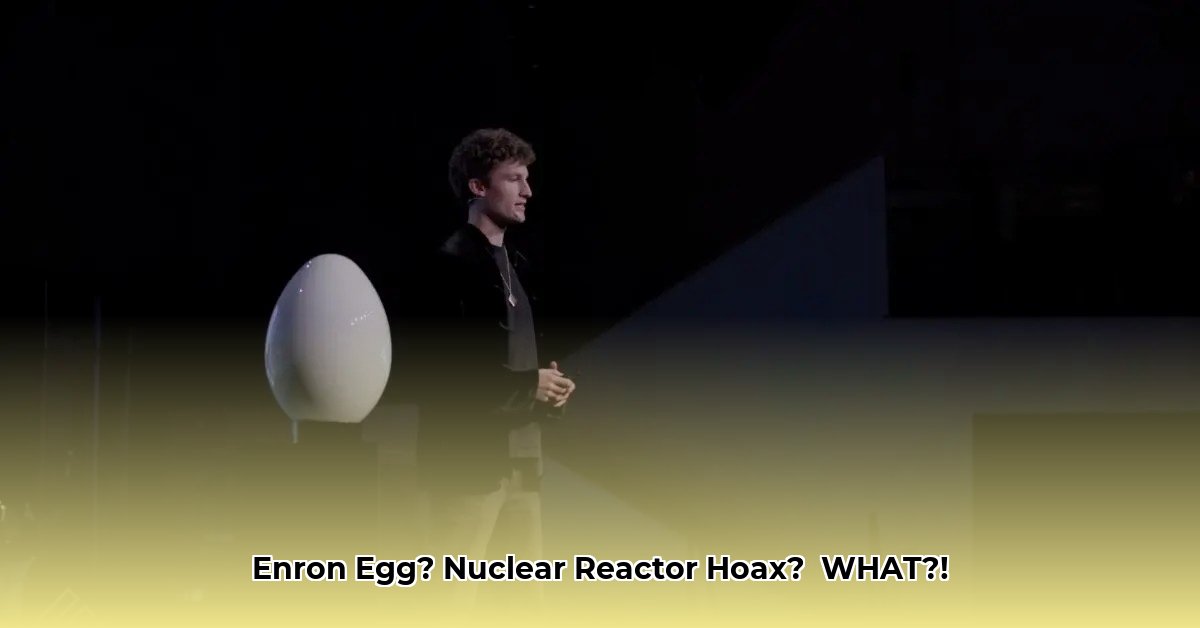What is the Enron Egg?
The Enron Egg is a hoax that went viral in early January 2025. It presented a fictional miniature nuclear reactor, shaped like an egg, claiming to power a home for a decade. This wasn’t a legitimate product but rather a satirical project designed to parody corporate hype and public anxieties surrounding energy and the pervasiveness of misinformation.
Cracking the Case: Who Hatched This Hoax?
The Enron Egg was the brainchild of Connor Gaydos, known for the “Birds Aren’t Real” satirical conspiracy theory. He revived the Enron name (reportedly for a mere $275) to launch this elaborate parody. This “new” Enron, with Gaydos at its helm, operates solely as a platform for satire and social commentary.
Inside the (Fake) Egg: A Look at the “Technology”
The fictional Enron Egg website and promotional video were crafted to mimic a genuine product launch. They used technical jargon, mentioning Uranium-Zirconium Hydride fuel rods, a 3D-printed Inconel heat exchanger, and a closed-loop cooling system. This was all part of the illusion, designed to sound convincing while simultaneously highlighting the absurdity of the claim. The science presented is entirely fabricated; such a device is impossible with current technology.
Why an Egg? Decoding the Symbolism
The egg shape likely carries multiple meanings. It might represent the fragility of the original Enron’s fraudulent business model, which ultimately crumbled. It could also symbolize the unfulfilled potential of clean energy solutions. Additionally, the egg shape is inherently memorable, contributing to the hoax’s viral nature.
The Real Target: More Than Just a Laugh
The Enron Egg hoax was more than just a prank; it was a pointed piece of social commentary. It satirized corporate greenwashing, poked fun at the hype surrounding tech solutions to complex issues, and highlighted the ease with which misinformation spreads online. By resurrecting the Enron name, the hoax also tapped into the collective memory of corporate greed and dishonesty, serving as a cautionary tale in the digital age. It raises important questions about the spread and dangers of misinformation and emphasizes the need for critical thinking. There is an ongoing debate about whether such hoaxes desensitize us to real threats.
Separating Fact from Fiction: Debunking the Claims
Here’s a clear breakdown:
| Feature | Enron Egg Claim | Reality |
|---|---|---|
| Functionality | Home Reactor | Satirical Hoax |
| Science | Advanced Tech | Pseudoscience, Technically Impossible |
| Creator | “New” Enron | Connor Gaydos (“Birds Aren’t Real” creator) |
| Purpose | Energy Solution | Social Commentary, Satire |
Enron’s History and the Hoax: A Reminder of the Past
The hoax deliberately invoked the history of the original Enron Corporation, which collapsed in 2001 due to massive accounting fraud. This connection wasn’t accidental. It served to amplify the hoax’s message about corporate malfeasance, reminding the public of the lasting impact of Enron’s actions and the ever-present risk of corporate dishonesty.
| Aspect | Original Enron | Enron Egg Hoax |
|---|---|---|
| Nature | Energy company engaged in fraudulent activities | Satirical art project |
| Purpose | Energy trading, distribution | Social commentary on misinformation |
| Outcome | Bankruptcy, legal repercussions | Viral online phenomenon |
| Key Figures | Kenneth Lay, Jeffrey Skilling | Connor Gaydos |
| Public Perception | Symbol of corporate corruption | Reminder of critical thinking |
A Timeline of Deception
- December 2024: The “new” Enron announces its return.
- Early January 2025: The Enron Egg is “hatched” online.
The Takeaway: A Lesson in Skepticism
The Enron Egg hoax serves as a powerful reminder to approach online information with a healthy dose of skepticism. While entertaining, it underscores the importance of critical thinking, fact-checking, and media literacy in navigating the digital landscape. It suggests that satire can be a potent tool for social commentary, but it also raises concerns about the blurring lines between reality and fiction online.







